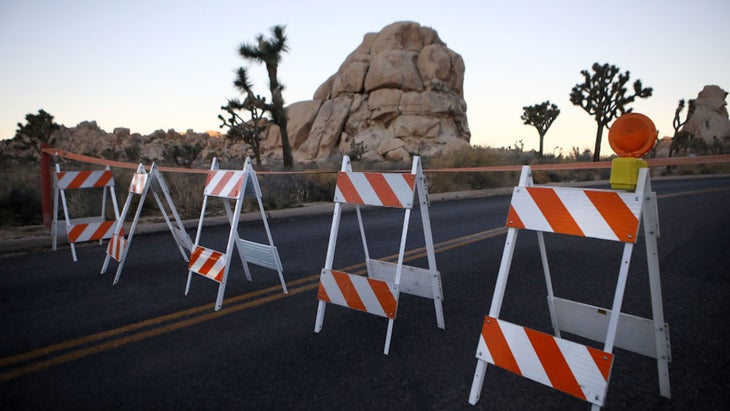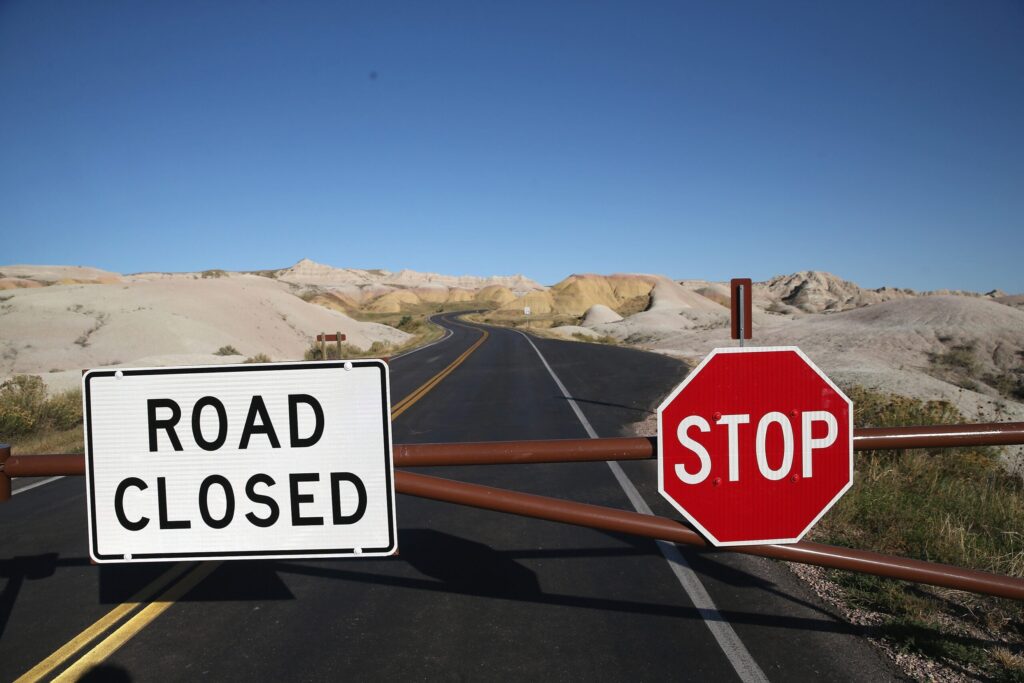Our national parks columnist Graham Averill covers what’s likely to be closed, and what to expect this time around
A barricade prevents visitors from entering the interior of the Badlands National Park on October 1, 2013 near Wall, South Dakota. (Photo: Photo by Scott Olson/Getty Images))
Updated October 1, 2025 05:15PM
Congressional leaders could not come together on a deal to fund the government ahead of the October 1 deadline, so a nationwide government shutdown is in effect as of October 1. That includes furloughing more than 9,000 national park employees. Conservation groups that raise fight for the health our national parks have urged the president to close the parks to visitors in the event of a shutdown to protect the resources within. Still, the Trump Administration is determined to keep the majority of our national parks open and is planning to use entrance fees already collected to pay a skeleton crew of staff at certain parks.
Thousands of park staff have been furloughed without pay, while the majority of the 433 national park units remain open without the requisite staff to protect the resources. When a shutdown looked imminent, more than 35 former national park superintendents wrote a letter to President Trump urging him to close the parks to visitors.
This isn’t the first government shutdown we’ve experienced under the Trump Administration. The last shutdown lasted 35 days, between December 2018 and January 2019. Parks remained open during that period, and the results were disastrous. Some parks were vandalized, cultural sites were damaged, and trash overflowed. Petroglyphs at Big Bend National Park were vandalized. Joshua Trees were chopped down in Joshua Tree National Park. Campgrounds were kept open in Death Valley, but the bathrooms were closed, causing sanitation problems, while many visitors drove off-road vehicles across sensitive areas of the desert. The trash was piled so high at Sequoia and Kings Canyon National Parks that they eventually had to shut the gates.
“If the government is shut down, the parks should be too,” says David Lamfrom, vice president of regional programs for the National Parks Conservation Association NPCA. “The reality is, when you say the parks are open, but don’t staff them, you’re taking America’s best idea and inviting in the worst. This isn’t speculation. This is what we saw happen last time around. We lived through this before, and we don’t want to see it happen again.”
As of October 1, the administration still plans to keep the majority of national park units open. What does that mean for visitors? It depends on the park you’re hoping to visit. According to the National Park Service shutdown contingency plan, park roads, lookouts, trails, and open-air memorials will remain accessible to visitors at most park units. Law enforcement and emergency response personnel will still be in operation as well.
The number of employees still working will vary from park to park, but remember that this shutdown is coming on the heels of a massive reduction in the national park staff from the Trump administration that saw a 24 percent reduction in park staff. Parks that collect fees will use available recreation fee balances to provide basic visitor services to maintain restrooms and trash collection in certain areas, some campground operations, and law enforcement staff.

What to Expect at National Parks During This Shutdown
It can be difficult to find park-specific information regarding what facilities are open in each park. During the last shutdown, the level of access and staff varied from park to park. But here’s what you can expect this time around on a fundamental level:
Park gates will remain open, but but staff will likely not be available to collect entrance fees. The NPCA estimates parks will lose as much as $1 million in fee revenue every day the shutdown continues. Reservations will also not be accepted during the shutdown. Roads and trails will remain open unless they become dangerous because of weather.
As a general rule, if a facility is locked during non-business hours, like buildings and gated parking lots, it should remain locked for the duration of the shutdown. So don’t roll into a park expecting to hit a bathroom at the visitor center.
Some guide services will still operate inside our parks, depending on their permit. Wildland Trekking, which runs trips in national parks throughout the country, released a statement saying they will continue to offer their services throughout the shutdown unless the situation changes prohibiting them from doing so.
Park websites will not be maintained, and conditions within the park will not be updated. Ditto for the NPS social media accounts.
Should You Visit a National Park During the Shutdown?
The tourism industry relying on these parks will tell you yes. For instance, Utah’s Bureau of Tourism released a statement today reiterating that its “Mighty Five” national parks are open to visitors. During the previous shutdown, the state stepped in to ensure that a basic level of visitor services, such as visitor centers and shuttle services, were available in certain parks.
However, conservation groups with a mission of protecting park resources are emphatic when they say people should not visit national parks during this government shutdown. Even if you have the best intentions and go to the park with wag bags and the ability to take out your own trash, you could put a strain on already limited resources if something goes wrong and you get hurt or lost.
“Every human being that goes into a park will create some sort of impact, whether it’s having to go to the bathroom, or walking across soil you’re not supposed to traverse, or getting hurt, and there won’t be the appropriate staff available to deal with that,” Lamfrom says. “These parks belong to us, and we want people to use them safely, but in a way that honors, respects and protects these special places now and into the future.”
Given the demand on resources, you might want to consider switching your trip to nearby state parks, which are fully staffed and operating with a business-as-usual mentality.
Need ideas of where to go? Check out this article I wrote about the best state parks in the country.


